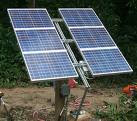
At the entrance of Sanyo Electric Co.'s new Salem factory, an awning holds the secret to the company's competitive edge in an increasingly cutthroat industry.
Black solar cells between two panes of glass cover the front walkway. And on a dim Oregon morning, the solar panels can collect sunshine from both sides, making them more efficient -- and more expensive -- than other brands.
"Sanyo is the only company that has this technology," said Robert Zerner, a business development executive based in San Jose, Calif. "No one else has a cell that can gather sunlight on the top and the bottom."
The differentiation is key for the Japanese electronics giant as it prepares to launch production at its new $80 million wafer plant, which opened Monday after nearly a year of construction. The factory employs 100 workers and expects to employ another 100 by April.
Sanyo Solar of Oregon -- as the local division is known -- represents a departure from other players in the state's growing solar industry, racing toward affordability to gain market share in a sector that's spawned hundreds of manufacturers worldwide. While other companies compete on price, Sanyo touts a unique and costly technology with a global manufacturing process that includes factories in Japan, Hungary and Mexico.
But the global recession continues to cloud the solar industry. Over the past year, prices have fallen by as much as 50 percent. And analysts predict many companies, particularly small and untested ones, will fail as prices continue to drop and profit margins shrink.
The state's investment in Sanyo -- nearly $45 million in government tax incentives and grants -- hinges on the company's success. Together, the subsidies total about $225,000 per job if the company employs 200.
"Focusing our efforts on clean technology even during these economic times is the right strategy for Oregon," Gov. Ted Kulongoski said at Monday's opening ceremony. "We are now competing globally for companies deciding to locate in new places and create jobs."
In Salem's 80-acre Renewable Energy and Technology Park, Sanyo's 130,000-square-foot factory houses the first two steps of solar manufacturing -- growing crystals and slicing them into wafers. From there, the wafers travel to Japan to be turned into cells, then to Hungary or Mexico to become finished panels.
By the time a Sanyo solar panel lands on a customer's rooftop, it will have made a lap around the world.
"We have a higher cost overall, but the performance benefit outweighs the cost," Zerner said. "You can put thousands and thousands of wafers in one pallet. They're really thin."
Sanyo North America -- the Sanyo Electric subsidiary that oversees the Oregon division -- intends to nearly double its solar panel production in Mexico and the United States by November 2010. Sanyo Electric, a leading manufacturer of rechargeable batteries, digital projectors, cameras and televisions, reported $18.1 billion in sales in 2009. The company has 86,100 employees worldwide.
The Oregon factory is critical to establishing a foothold in the solar market, said Mitsuru Homma, executive vice president of Sanyo Electric.
"Sanyo aims to be the leading company in environmental energy," said Homma, who traveled from Japan to tour the Salem plant. "We need to reduce the production cost closer to the cost of current energy generation."
In Salem, the company will pump out about 350,000 200-watt solar panels per year, with the potential to expand onto another 20 acres. This week, Sanyo also will be opening a new module assembly plant in Monterrey, Mexico.
Sanyo's combines two solar technologies, monocrystalline and thin-film. Zerner said this hybrid technology makes Sanyo panels among the most efficient, with about 25 percent better performance than SolarWorld, its German competitor. The Sanyo panels, which are also about 15 percent more expensive, are better for specific conditions, including extreme heat or cloudy skies.
At Pringle Creek Community, a green subdivision under construction in Salem, Sanyo panels have already been installed.
"It's good for residences in Oregon because you have limited space," said Alan Hickenbottom, president of Tanner Creek Energy, a commercial installer who often uses solar products from companies with factories in Oregon. "It's a beautiful panel."
Sanyo may never consolidate all of its manufacturing processes in one place, as SolarWorld is doing at its massive campus in Hillsboro.
The company worries about theft of its technology. By keeping cell production in Japan, the company hopes to protect its technology, spokesman Aaron Fowles said.
"In Japan, people are lifetime employees," Fowles said. "In the U.S., people switch employers a lot."
The growing competition in the industry also sparks rivalries between governments, hoping to land big companies and high-paying jobs.
To lure the company to Salem, city economic development officials threw in up to five years of property tax exemptions, which total about $1.2 million each year. Road and infrastructure improvements totaled about $1 million. Another $180,000 for a sewer and water connection fee waiver.
Under the Business Energy Tax Credit program, Sanyo will receive $40 million in credits for creating 200 jobs, said Marc Zolton, of the Oregon Business Development Department. In addition, the company received $225,000 for workforce training.
Kulongoski said Monday more effort will be made to grow Oregon's solar industry, which has already resulted in high-paying jobs and promises an additional $100 million in investment in the coming months.
"We have the highest percentage of green energy jobs in the nation," Kulongoski said. "This growth is not by accident."
SOURCE:
Oregon Live
 Residential solar electric systems have become extremely popular in New York state because of a variety of incentive programs and tax breaks that are available to homeowners.
Residential solar electric systems have become extremely popular in New York state because of a variety of incentive programs and tax breaks that are available to homeowners.











